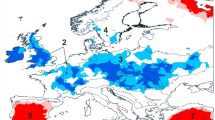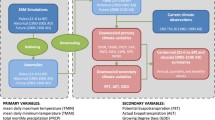Abstract
High-resolution (downscaled) projections of future climate conditions are critical inputs to a wide variety of ecological and socioeconomic models and are created using numerous different approaches. Here, we conduct a sensitivity analysis of spatial predictions from climate envelope models for threatened and endangered vertebrates in the southeastern United States to determine whether two different downscaling approaches (with and without the use of a regional climate model) affect climate envelope model predictions when all other sources of variation are held constant. We found that prediction maps differed spatially between downscaling approaches and that the variation attributable to downscaling technique was comparable to variation between maps generated using different general circulation models (GCMs). Precipitation variables tended to show greater discrepancies between downscaling techniques than temperature variables, and for one GCM, there was evidence that more poorly resolved precipitation variables contributed relatively more to model uncertainty than more well-resolved variables. Our work suggests that ecological modelers requiring high-resolution climate projections should carefully consider the type of downscaling applied to the climate projections prior to their use in predictive ecological modeling. The uncertainty associated with alternative downscaling methods may rival that of other, more widely appreciated sources of variation, such as the general circulation model or emissions scenario with which future climate projections are created.


Similar content being viewed by others
References
Acevedo P, Jiménez-Valverde A, Lobo JM, Real R (2012) Delimiting the geographical background in species distribution modelling. J Biogeogr 39:1383–1390
Allouche O, Tsoar A, Kadmon R (2006) Assessing the accuracy of species distribution models: prevalence, kappa and the true skill statistic (TSS). J Appl Ecol 43:1223–1232
Araújo MB, Guisan A (2006) Five (or so) challenges for species distribution modeling. J Biogeogr 33:1677–1688
Araújo MB, Luoto M (2007) The importance of biotic interactions for modelling species distributions under climate change. Global Ecol Biogeogr 16:743–753
Araújo MB, Peterson AT (2012) Uses and misuses of bioclimatic envelope modeling. Ecology 93:1527–1539
Araújo MB, Pearson RG, Thuiller W, Erhard M (2005) Validation of species-climate impact models under climate change. Glob Change Biol 11:1504–1513
Austin MP (2002) Spatial prediction of species distribution: an interface between ecological theory and statistical modeling. Ecol Model 157:101–118
Barve N, Barve V, Jiménez-Valverde A, Lira-Noriega A, Maher SP, Peterson AT, Soberón J, Villalobos F (2011) The crucial role of the accessible area in ecological niche modeling and species distribution modeling. Ecol Model 222:1810–1819
Cahill AE, Aiello-Lammens ME, Fisher-Reid MC, Hua X, Karanewsky CJ, Ryu HY, Sbeglia GC, Spagnolo F, Waldron JB, Warsi O, Wiens JJ (2012) How does climate change cause extinction? Proc R Soc B, published online 17 Oct 2012. doi:10.1098/rspb.2012.1890
Chapman DS (2010) Weak climatic associations among British plant distributions. Glob Ecol Biogeogr 19:831–841
Cutler DR, Edwards TC Jr, Beard KH, Cutler A, Hess KT, Gibson J, Lawler JJ (2007) Random forests for classification in ecology. Ecology 88:2783–2792
Elith J, Graham CH (2009) Do they? How do they? WHY do they differ? On finding reasons for differing performances of species distribution models. Ecography 32:66–77
Elith J, Kearney M, Phillips S (2010) The art of modelling range-shifting species. Methods Ecol Evol 1:330–340
Fielding AH, Bell JF (1997) A review of methods for the assessment of prediction errors in conservation presence/absence models. Environ Conserv 24:38–49
Fowler HJ, Blenkinsop S, Tebaldi C (2007) Linking climate change modelling to impacts studies: recent advances in downscaling techniques for hydrological modelling. Int J Climatol 27:1547–1578
Franklin J (2009) Mapping species distributions: spatial inference and prediction. Cambridge University Press, New York
Freeman EA, Moisen GG (2008) A comparison of the performance of threshold criteria for binary classification in terms of predicted prevalence and kappa. Ecol Model 217:48–58
Graham CH, Loiselle BA, Velásquez-Tibatá J, Cuesta FC (2011) Species distribution modeling and the challenge of predicting future distributions. In: Herzog SK, Martínez R, Jørgensen PM, Tiessen H (ed) Climate change and biodiversity in the Tropical Andes, Inter-American Institute for Global Change Research (IAI) and Scientific Committee on Problems of the Environment. São José dos Campos, Brazil, pp 295–310. http://www.iai.int
Guisan A, Thuiller W (2005) Predicting species distribution: offering more than simple habitat models. Ecol Lett 8:993–1009
Hellström C, Chen D, Achberger C, Räisänen J (2001) Comparison of climate change scenarios for Sweden based on statistical and dynamical downscaling of monthly precipitation. Clim Res 19:45–55
Hijmans RS, Cameron SE, Parra JL, Jones PG, Jarvis A (2005) Very high resolution climate surfaces for global land areas. Int J Climatol 25:1965–1978
Hirzel AH, Hausser J, Chessel JD, Perrin N (2002) Ecological niche-factor analysis: how to compute habitat-suitability maps without absence data? Ecology 83:2027–2036
Intergovernmental Panel on Climate Change (2007) Climate change 2007: the physical science basis. In: Solomon S, Qin D, Manning M, Chen Z, Marquis M, Averyt KB, Tignor M, Miller HL (eds) Contribution of working group 1 to the fourth assessment report of the intergovernmental panel on climate change. Cambridge University Press, Cambridge, pp 433–498
Kanamitsu M, Yoshimura K, Yhang Y-B, Hong S-Y (2010) Errors of interannual variability and trend in dynamical downscaling of reanalysis. J Geoph Res 115:D17115
Kremen C et al (2008) Aligning conservation priorities across taxa in Madagascar with high-resolution planning tools. Science 320:222–226
Liaw A, Wiener M (2002) Classification and regression by randomForest. R News 2(3):18–22
Lomba A, Pellissier L, Randin C, Vicente J, Moreira F, Honrado J, Guisan A (2010) Overcoming the rare species modelling paradox: a novel hierarchical framework applied to an Iberian endemic plant. Biol Conserv 143:2647–2657
Manel S, Williams HC, Ormerod SJ (2001) Evaluating presence–absence models in ecology: the need to account for prevalence. J Appl Ecol 38:921–931
Maraun D, Wetterhall H, Ireson AM, Chandler RE, Kendon EJ, Widmann M, Brienen S, Rust HW, Sauter T, Themeßl M, Venema VKC, Chun KP, Goodess CM, Jones RG, Onof C, Vrac M, Thiele-Eich I (2010) Precipitation downscaling under climate change: recent developments to bridge the gap between dynamical models and the end user. Rev Geophys 48:RG3003
Mitikka V, Heikkinen RK, Luoto M, Araújo MB, Saarinen K, Poyry J, Fronzek S (2008) Predicting range expansion of the map butterfly in northern Europe using bioclimatic models. Biodivers Conserv 17:623–641
New M, Lister D, Hulme M, Makin I (2002) A high-resolution data set of surface climate over global land areas. Clim Res 21:1–25
Phillips SJ, Dudík M, Elith J, Graham CM, Lehmann A, Leathwick J, Ferrier S (2009) Sample selection bias and presence-only distribution models: implications for background and pseudo-absence data. Ecol Appl 19:181–197
Povilitis A, Suckling K (2010) Addressing climate change threats to endangered species in U.S. recovery plans. Conserv Biol 24:372–376
Ramirez J, Jarvis A (2008) High resolution statistically downscaled future climate surfaces, International Center for Tropical Agriculture (CIAT); CGIAR Research Program on Climate Change, Agriculture and Food Security (CCAFS), Cali, Colombia. http://www.ccafs-climate.org/statistical_downscaling_delta
Rapacciuolo G, Roy DB, Gillings S, Fox R, Walker K, Purvis A (2012) Climatic Associations of British species distributions show good transferability in time but low predictive accuracy for range change. PLoS ONE 7:1–7
Real R, Márquez AL, Olivero J, Estrada A (2010) Species distribution models in climate change scenarios are still not useful for informing policy planning: an uncertainty assessment using fuzzy logic. Ecography 33:304–314
Rowland EL, Davison JE, Graumlich LJ (2011) Approaches to evaluating climate change impacts on species: a guide to initiating the adaptation planning process. Environ Manage 47:322–337
R Development Core Team (2012) R: A language and environment for statistical computing, R Foundation for Statistical Computing, Vienna. www.R-project.org
Stefanova L, Misra V, Chan S, Griffin M, O’Brien JJ, Smith TJ III (2012) A proxy for high-resolution regional reanalysis for the Southeast United States: assessment of precipitation variability in dynamically downscaled reanalyses. Clim Dynam 38:2449–2466
Syphard AD, Franklin J (2009) Differences in spatial predictions among species distribution modeling methods vary with species traits and environmental predictors. Ecography 32:907–918
Tabor K, Williams JW (2010) Globally downscaled climate projections for assessing the conservation impacts of climate change. Ecol Appl 20:554–565
VanDerWal J, Shoo LP, Graham C, Williams SE (2009) Selecting pseudo-absence data for presence-only distribution modeling: how far should you stray from what you know? Ecol Model 220:589–594
Watling JI, Romañach SS, Bucklin DN, Speroterra C, Brandt LA, Pearlstine LG, Mazzotti FJ (2012) Do bioclimate variables improve performance of climate envelope models? Ecol Model 246:79–85
Wilby RL, Fowler HJ (2010) Regional climate downscaling. In: Fung F, Lopez A, New M (eds) Modelling the impact of climate change on water resources. Wiley, Chichester, pp 34–85
Wood AW, Maurer EP, Kumar A, Letternmaier DP (2002) Long-range experimental hydrologic forecasting for the eastern United States. J Geophys Res 107:4429
Acknowledgments
We thank Lydia Stefanova at COAPS for assisting us with the dynamically downscaled (CLAREnCE10) projections and three anonymous reviewers for their valuable comments and suggestions. Funding for this work was provided by the U.S. Fish and Wildlife Service, the National Park Service (Everglades and Dry Tortugas National Parks) through the South Florida and Caribbean Cooperative Ecosystem Studies Unit, and the U.S. Geological Survey (Greater Everglades Priority Ecosystems Science). Views expressed here do not necessarily represent the views of the U.S. Fish and Wildlife Service. Use of trade, product, or firm names does not imply endorsement by the U.S. Government.
Author information
Authors and Affiliations
Corresponding author
Rights and permissions
About this article
Cite this article
Bucklin, D.N., Watling, J.I., Speroterra, C. et al. Climate downscaling effects on predictive ecological models: a case study for threatened and endangered vertebrates in the southeastern United States. Reg Environ Change 13 (Suppl 1), 57–68 (2013). https://doi.org/10.1007/s10113-012-0389-z
Received:
Accepted:
Published:
Issue Date:
DOI: https://doi.org/10.1007/s10113-012-0389-z




